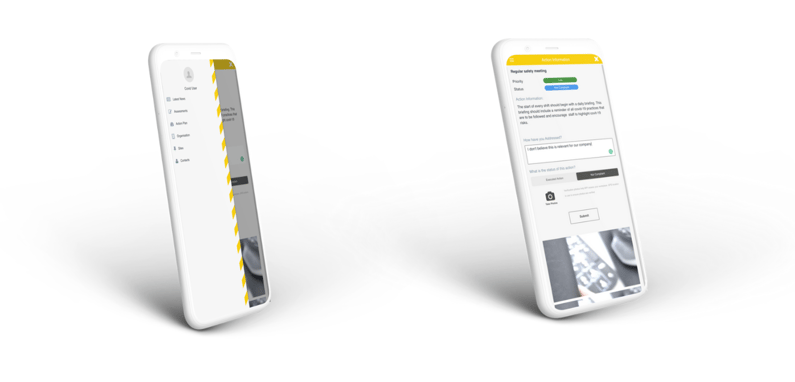The Covid-19 era has accelerated digital transformation across many industries, but digitisation has been disrupting business models well before the pandemic took hold. Businesses, government agencies and enterprise-level organisations are always seeking to streamline workflows and automate processes wherever possible. What Covid-19 has accentuated is the need to deploy these software solutions as quickly as possible.
Lockdown has presented numerous challenges for most industries, largely because social distancing guidelines meant that people need to avoid being physically near each other. This is especially the case for organisations that need to check compliance with regulations (e.g. hygiene standards, health and safety requirements, fire safety regulations).
One such organisation approached Optimation recently, asking if there was an application that could help ensure compliance with health and safety regulations in workspaces with many people e.g. work places, factories, logistic centres. Under normal circumstances, this would involve an agent of the organisation visiting the work site, inspecting the physical environment, and ensuring that it met requirements.
With the shift in circumstances, the pressing issue was carrying out these compliance checks while avoiding or reducing contact at the same time. In addition to this, the sheer scale of inspections required far exceeded what would previously have been a normal workload for inspectors travelling from site to site. They needed a solution to help:
- perform site inspections based on a given set of criteria
- adhere to social distancing guidelines and hygienic practices
- confirm that the site met the necessary health and safety obligations.
Given these requirements, the organisation approached Optimation with the challenge of delivering technology that could perform these tasks, allow a single inspector to service many more sites than normal, and reduce the need for physical contact.
Since there are many businesses across a range of industries that require site inspections to ensure compliance, the government agency needed something that would facilitate health and safety compliance effectively even as New Zealand moves down the levels, until we're out of Covid-19 restrictions completely.
A conventional approach would be to scope out the customer's requirements, and then develop and build an application based on those requirements. Typically, an end-to-end solution using traditional methodologies would take months, and in these uncertain times, does not address the need for a quick response.
For the government agency in question, we employed a ‘low-code development’ methodology utilising Outsystems' low-code/no-code approach to agile solution creation. Outsystems allows us to visually develop an entire application, and easily integrate it with existing systems. This approach prioritises swift prototype solutions that can be put into production very quickly.

Over a period of only four days, Optimation were able to ideate, design and configure a virtual site inspection and workflow demonstration solution that could meet the challenges of contactless registration, virtual site inspection, tracking and compliance. The OutSystems platform provides the scale, security and maturity, yet no restrictions in terms of simple and customisable workflow and fine tuning for an organisation's specific needs. This flexibility is a major benefit for customers when compared to off-the-shelf solutions that don't fully meet the mark. In addition to that, it provides a 100% bespoke process flow. All the customer's individual, specific business needs were accounted for and pulled together in this fully tailored, customised solution.
The result is an app a site manager uses to effectively self-audit, registering with a unique business number and sending geo-tagged images and video back to the audit authority to demonstrate compliance. This virtual / contactless site inspection prototype includes capabilities like:
- Device-specific functionality - it can be used on smartphones, PCs, browsers and tablets
- Workspace registration - allows for workspaces to register with the government agency using their business numbers
- Generating customisable industry-specific assessments or questionnaires
- A configurable, all-in-one platform to create, distribute and receive responses. Based on those responses, then determine if the work site is compliant, or if a follow-up is needed
- The ability to provide geo-tagged photos and videos; the work site can record images showing that workspaces and equipment etc. are compliant for assessment by the agency back at base
- The potential to run in-app video chat for directed site walkthroughs and follow up engagement
The solution can be used both online and offline. What this means is that work sites with limited internet connectivity can still record geo-tagged images and videos, which would then synchronise with the app once back in range.

Our design thinking expertise coupled with the cloud based Outsystems’ low-code / no-code approach meant that we were able to work with the government agency to ideate and actualise very quickly. We implemented it, and set up a fully functional demonstrator, which could be further modified as needed – all within four days. It’s a powerful example of how Optimation employ rapid solution development techniques to turn around ideas and swiftly create bespoke, fully secure solutions.
The digital solution we’ve developed is an innovative response to the wave of digital transformation happening globally. In fact, the software could be adapted and applied to all manner of organisations, from city councils to insurance companies where site inspections and assessments need to be carried out on a regular basis. For instance, a potential application for city councils would be to perform site inspections such as checking pool fences, or food hygiene certification in a remote and contactless way.
Now that you've read what's possible for even the most complex legacy systems to transform, if you are considering a digital transformation for your own business, read our comprehensive guide to low code development and how it can help your business.
Although a response to Covid-19, this solution is an assertion of the new digital paradigm emerging; it's technology that will enable processes to be streamlined and to gain efficiencies for organisations through the pandemic and beyond.
Need a rapid software solution? Get in touch - we'd love to talk with you about how Optimation can help your business benefit from digital transformation and a swift turnaround.